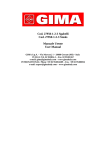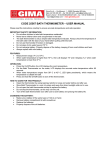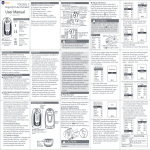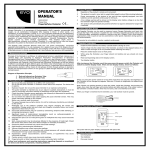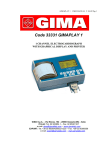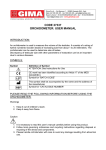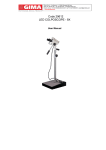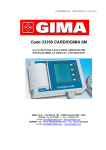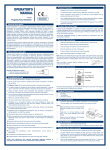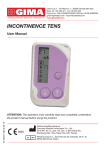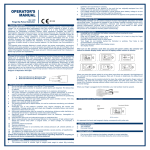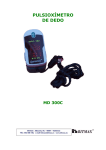Download manuale pulsoximetro EN
Transcript
Gima S.p.A. - Via Marconi, 1 - 20060 Gessate (MI) Italy Italia: tel. 199 400 401 - fax 199 400 403 Export: tel. +39 02 953854209/221/225 fax +39 08 95380056 [email protected] - [email protected] www.gimaitaly.com OPERATOR’S MANUAL REV. 0 - 04/12 FINGER PULSE OXIMETER GENERAL DESCRIPTION Oxygen saturation is a percentage of oxyhemoglobin (Hb02) capacity, compounded with oxygen, by all combinative hemoglobin (Hb) capacity in blood. In other words, it is consistency of Oxyhemoglobin in blood. It is a very important parameter for the Respiratory Circulation System. Many respiratory diseases can result in oxygen saturation being lowered in human blood. Additionally, the following factors can reduce oxygen saturation: automatic regulation of organ dysfunction caused by anesthesia, intensive postoperative trauma, injuries caused by some medicai examinations. That situation might result in light headedness, asthenia, and vomiting. Therefore, it is very important to know the oxygen saturation of a patient so that doctors can find problems in a timely manner. The fingertip pulse oximeter features small size, low power consumption, convenient operation and portability. It is only necessary for a patient to put one of his fingers into the fingertip photoelectric sensor for diagnosis, and a display screen will show oxygen saturation. It has been proven in clinical experiments that it also features high precision and repeatability. MEASUREMENT PRINCIPLE Principle of the oximeter is as follows: a mathematical formula is established making use of Lambert Beer Law according to spectrum absorption characteristics of reductive hemoglobin (RHb) and oxyhemoglobin (Hb02) in glow and near-infrared zones. Operation principle of the instrument: photoelectric oxyhemoglobin inspection technology is adopted in accordance with capacity pulse scanning and recording technology, so that two beams of different wavelength oflights (660nm glow and 905nm near infrared light) can be focused onto a human nail tip through a clamping finger-type sensor. A measured signal obtained by a photosensitive element, will be shown on the oximeter's display through process in electronic circuits and microprocessor shown on the oximeter's display through electronic circuits and a microprocessor. Diagram of operation principle 1. Red and infrared-ray emission tube 2. Red and infrared-ray receipt tube PRODUCT OPERATION SCOPE Fingertip PULSE OXIMETER is a portable non-invasive, spot-check, oxygen saturation of arteria' hemoglobin (SpO2) and pulse rate of adult and pediatric patient at home, and hospital (including clinical use in internist/surgery, anesthesia, intensive care etc). It is not for continuously monitoring. PRECAUTIONS FOR USE 1. Do not use the pulse oximeter in an MRI or CT environment. 2. Do not use the pulse oximeter in situations where alarms are required. The device has no alarms. 3. Explosion hazard: do not use the pulse oximeter in an explosive atmosphere. 4. The pulse oximeter is intended only as an adjunct in patient assessment. It must be used in conjunction with other methods of assessing clinical signs and symptoms. 5. Check the pulse oximeter sensor application site frequently to determine the positioning of the sensor and circulation and skin sensitivity of the patient. 6. Do not stretch the adhesive tape while applying the pulse oximeter sensor. This may cause inaccurate readings or skin blisters. 7. Before use, carefully read the manual. 8. The pulse oximeter has no SpO2 alarms; it is not for continuous monitoring. 9. Prolonged use or the patient's condition may require changing the sensor site periodically. Change sensor site and check skin integrity, circulatory status, and correct alignment at least every 4 hours. 10. Inaccurate measurements may be caused by autoclaving, ethylene oxide sterilizing, or immersing the sensors in liquid. 11. Significant levels of dysfunctional hemoglobins (such as carbonxyhemoglobin or methemoglobin) may affect the readings. 12. Intravascular dyes such as indocyanine green or methylene blue. 13. SpO2 measurements may be adversely affected in the presence of high ambient light. Shield the sensor area (with a surgical towel, or direct sunlight. 14. Excessive patient movement may cause inaccurate readings. 15. High-frequency electrosurgical interference may cause inaccurate readings. 16. Venous pulsations may cause inaccurate readings. 17. Placement of a sensor on an extremity with a blood pressure cuff, arteria' catheter, or intravascular line. 18. The patient has hypotension, severe vasoconstriction, severe anemia, or hypothermia, may cause inaccurate readings. 19. The patient is in cardiac arrest or is in shock. 20. Fingemail polish or false fingernails may cause inaccurate SpO2 readings. FoIIow local ordinances and recycling instructions regarding disposal or recycling of the device and device components, including batteries. PRODUCT PROPERTIES 1. Operation of the product is simple and convenient. 2. The product is small in volume, light in weight and convenient in carrying. 3. Power consumption of the product is low and the two AAA batteries can be operated continuously for 30 hours. 4. A low voltage warning will be indicated in visual window when battery voltage is so low that normal operation of the oximeter might be influenced. 5. The product will automatically be powered off when no signal is in the product for longer than 5 seconds. 6. No need to maintance except change batteries. OPERATION INSTRUCTIONS Oxygen saturation Pulse rate SpO2% waveform Power button BATTERY INSTALLATION 1. Put the two AAA batteries into battery compartment in correct polarities. 2. Push the battery cover horizontally along the arrow shown as below: Notes: (1). Battery polarities should be correctly installed. (2). Otherwise, damage may be caused to the device. (3). Please put in or remove batteries in right order, or may cause damage to the device bracket. (4). Please remove the batteries if the oximeter will not be used for a long time. STRAP INSTALLATION 1. Thread thinner end of the strap through the loop. 2. Thread thicker end of the strap through the threaded end before pulling it tightly. OPERATION INSTRUCTIONS 1. Install two AAA batteries into battery cassette before closing its cover. 2. Insert one finger into the oximeter as following picture, the nail surface must be upward. 3. Insert one finger into rubber hole of the oximeter fully. 4. Press the power button on the front case. 5. Finger and body should not tremble during measuring. 6. Read corresponding data on the display screen directly. 7. Finger leave the rubber hole for 5 seconds, it can auto off. Note: please use medicai alcohol to clean the rubber, oximeter inside. Also, clean the test finger with alcohol before and after each test. (The rubber inside of the oximeter is medicai rubber, which has no toxins, and is not harmful to the skin). DETAILED DESCRIPTION OF PRODUCT FUNCTIONS 1. Display Type: OLED 2. SpO2: Measurement range: 35%-100% Accuracy: 70%-99%, ±2%; no definition. 3. Pulse Rate: Measure range: 30-250BPM Accuracy: 30-250BPM, ±2%. Pulse rate display model: bargraph Indicator 4. Power Requirements: Two AAA alkaline batteries Power consumption: less than 30mA Low power indication: the low voltage lamp is lighted when the voltage less than 2.6V (error ±0. 2V) Battery Life: two AAA 1.5V, 600mAh alkaline batteries could be continuously operated as long as 30 hours. 5. Dimension: L x W x H: 57mm x 31.5mm x 30.5mm 6. Environment Requirements: Operation Temperature: 5-40°C Storage Temperature: -20-70°C Ambient Humidity: Work: 15%-90% Storage : 15%-93% 7. EMC of this product complies with IEC60601-1-2 standard. 8. Measurement performance in low perfusion condition: required the test equipment (FLUKE-INDEX 2XL) the pulse wave is available without failure when the simulation pulse wave amplitude is at 0.4%. 9. Interference resistance capacity against ambient light: Device works normally. when mixed noise produced by FLUKE-INDEX 2XL. PRODUCT ACCESSORIES POSSIBLE PROBLEMS AND RESOLUTIONS Problems Possible reason Solutions SpO2 or PR can not be shown normally Finger is not inserted correctly Retry by inserting the finger SpO2 or PR is shown 1. Finger might not be inserted deep enough. 2. Finger is trembling or patient's body is in movement status. 1. Retry by inserting the finger 2. Try not to move The Oximeter can not be powered on 1. Power of batteries might be inadeguate or not be there at all 2. Batteries might be installed incorrectly 3. The oximeter might be damaged 1. Please replace batteries Indication lamps are suddenly off 1. The product is automatically powered off when no signal is detected longer than 5 seconds 2. Power quantity of the batteries is started being inadeguate 1. Norma 2. Please reinstall the batteries 3. Please contact with local customer service centre 2. Replace the batteries SYMBOL DEFINITIONS 1. One strap 2. Two batteries 3. One user's manual Type B applied part MAINTENANCE AND STORAGE Attention, refer to the manual before using 1. Replace the batteries in time when low voltage lamp is lighted. 2. Clean surface of the fingertip oximeter before it is used in diagnosis for patients. 3. Remove the batteries inside the battery cassette if the oximeter will not be operated for a long time. 4. It is best to preserve the product in a piace where ambient temperatures is -10°C~40°C (14~104°F) and relative humidity is: 15%~80%. 5. It is recommended that the product should be kept in a dry environment anytime. A wet ambient might affect its lifetime and even might damage the product. 6. Please follow the law of the local government to deal with used batteries Oxygen saturation Heart rate (BPM) Low power indication No SpO2 Alarm Serial No CALIBRATING THE PULSE OXIMETER 1. Can not be used to assess the functional test equipment oximeter accuracy. 2. Produced using FLUKE oxygen analog meter, set the standard curve BCI oximeter calibration curve. Note: The functional tester cannot be used to assess the accuracy of the oximeter. The test methods used to establish the Sp02 accuracy is clinical testing. The oximeter used to measure the arterial haemoglobin oxygen saturation levels and these levels are to be compared to the levels determined from arterial blood sampling with a CO-oximeter. IPX1 Impermeability index APPLICABLE MODELS This manual applies to the following product types: SH03002


